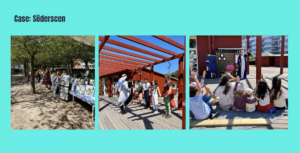Learning Resources: How to Approach Creative Cross-Innovations?

In 2024, The Northern Dimension Partnerships on Culture (NDPC) produced a series of webinars to highlight how the concept of “Creative Cross-Innovation” contribute to redefining the role of artists in contemporary society. This notion is thus key to understanding NDPC’s projects — whose core vision focuses on bridging the gap between the cultural sector and other sectors for sustainable development.
Learn more about it in the article below!
RESOURCE 1: UNDERSTANDING THE CONCEPT OF CROSS-INNOVATION AS AN ALTERNATIVE INNOVATION SYSTEM.
Speaker: Jenny Kornmacher, Creative Industries Development, Region Skåne, Sweden
Jenny is an experienced expert and project lead with a robust background in creative industries and innovation in Germany, Sweden and Europe in wide. She specializes in the potentials of the creative sectors as an alternative innovation system, driving transformative change by cross-sectorial initiatives. https://www.linkedin.com/in/jenny-kornmacher-315a4326/

Credits: Jenny Kornmacher (presentation)
Key takeaways:
- There is a need to rethink traditional models of “Research & Development = Innovation,” it is about interdisciplinary collaboration.
- Innovation must account for values beyond growth, given our limited resources.
- We have fantastic competences within the artistic and cultural sector, the arts are essential in driving sustainability through creative solutions.
- Introducing one cross-innovative case study about the Digital Future Concert Experience from Southern Sweden.
Link to the resource: here
Other sources:
- This concept is key to CCI4Change, one of our current projects, where NDPC works in collaboration with Region Skåne to transform citizens’ energy habits with creative professionals: https://ndpculture.org/projects/cci4change/
RESOURCE 2: TURNING TRANSACTIONAL RELATIONSHIPS INTO COLLABORATION: JOINT DECISIONS FOR COLLECTIVE OUTCOMES.
Speaker: Abbas Sbeity, Creative Insights Studio, Helsingborg, Sweden
Abbas is a designer, curator, and cultural manager based in Helsingborg, Sweden. He leads Creative Insights Studio, offering design and research consultancies for the public sector and development agencies, and, among other activities, he is the developer of the Seed Money Initiative Roadmap, a key element of BSR Cultural Pearls Project. https://www.linkedin.com/in/abbassbeity/

Credits: Jenny Kornmacher (presentation)
Key takeaways
- Moving beyond simple service exchanges to collaborative partnerships allows for shared ownership and lasting impact across sectors.
- It’s important to understand that the public sector, private sectors, and civil society do not operate in isolation: it is all interconnected!
- Engaging local residents and civil society in public projects, as seen in Helsingborg’s Söderscen, builds trust, fosters ownership, and helps overcome stigmatization.
- Combining top-down guidance with grassroots involvement creates dynamic, adaptable partnerships that bridge bureaucratic gaps and enhance creative problem-solving.
Link to the resource: here
Link to the dedicated article: here
Other sources:
- Learn more about Söderscen: link
- The concept of cross-innovation is key to BSR Cultural Pearls, one of our current projects, where NDPC works in collaboration with a broad network of partners to develop culture-driven social resilience among municipalities in the Baltic Sea region. https://ndpculture.org/projects/bsr-cultural-pearls/
RESOURCE 3: HOW TO APPROACH THE CONCEPT OF CROSS-INNOVATION AND WHAT TO CONSIDER WHEN INITIATING A COLLABORATION?
Speaker: Krista Petäjäjärvi, Expert in Arts-Based Innovations, Northern Dimension Partnership on Culture (NDPC)
Krista is an expert in arts-based innovation, a dedicated artist, and a developer focused on advancing the role of art in driving societal change. She designs and facilitates practical processes, concepts, and methodologies to integrate artistic practices into development processes, evaluating actions, gathering evidence, lecturing, mentoring, and advocating for the role of art in sustainable development and innovation. https://www.linkedin.com/in/krista-pet%C3%A4j%C3%A4j%C3%A4rvi/

Credits: NDPC policy brief
Key takeways:
- Arts and culture professionals can contribute their unique expertise across industries—public, private, and NGO sectors—to co-create new value.
- Success in cross-innovative projects hinges on establishing shared goals and fostering equal partnerships: artistic or creative expertise is an integral part of the collaboration.
- A case study such as dancer, choreographer Iina Taijonlahti’s work with tech company Futurice on a humanoid robot.
- To initiate a collaboration, you will need clear roles, defined responsibilities, and mutual trust; involvement of intermediary parties needs to be considered to support the partnership.
Link to the resource: here
Other sources:
- Check out NDPC dedicated policy brief on ‘Arts & Design-Based Collaboration and Cross-Innovation:’ here
OTHER TAKEAWAYS: FOOD FOR THOUGHT AND FURTHER DISCUSSION
- The societal, social and ecological challenges are urgent and complex in their nature. There is a shared sentiment that the existing business models alone are no longer sufficient to tackle complex problems, and sustainability must form the foundation of collaborative efforts.
- In the early 2000s, the focus of arts collaborations with other fields was more about exploring the business potentials, but now the sustainability issues lay the common ground for formatting of new collaborations: this shift suggests that sustainability is now not only an ethical priority but also a critical enabler of cross-sectorial partnerships.
- One central topic is the goals of the incentives, which have to be very clear for all parties: this includes rethinking the legal frameworks that guide intellectual property (IP) rights, especially in an era where artificial intelligence is driving rapid changes in how knowledge is created and shared, and where we may not have the same kind of intellectual property rights in the future.
- The role of intermediaries—organizations or individuals who help bridge the gap between different sectors —is very important! These intermediaries are essential for facilitating communication, sharing best practices, and guiding the collaboration from inception to implementation. Intermediaries are needed to build these bridges between arts, culture and creative professionals to work in synergy with public, private and third sector professionals.
- Intermediaries serve not only as connectors but also as champions of knowledge-sharing and skill development. As the field of cross-innovation continues to grow, the emphasis on capacity-building and skill development will be crucial for sustaining these collaborative efforts. The role of intermediaries in facilitating forward creative cross-innovations need to be acknowledged and supported.
